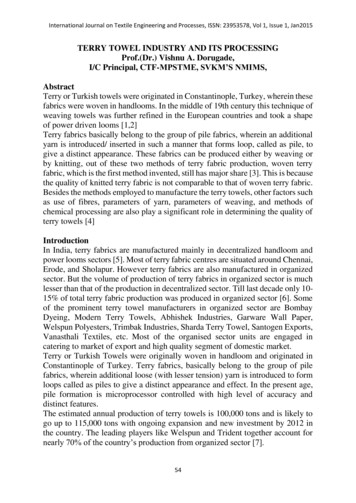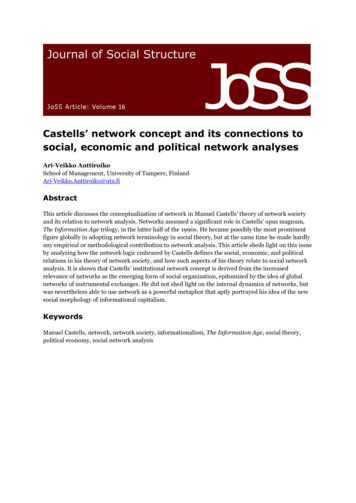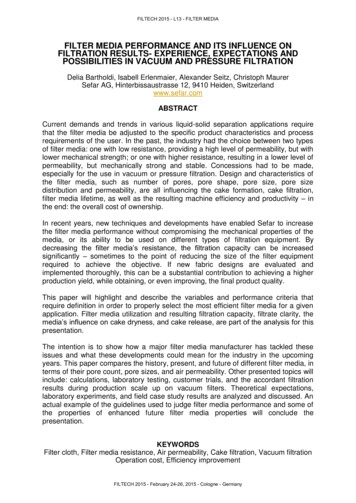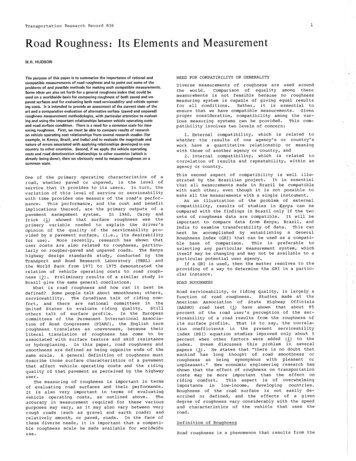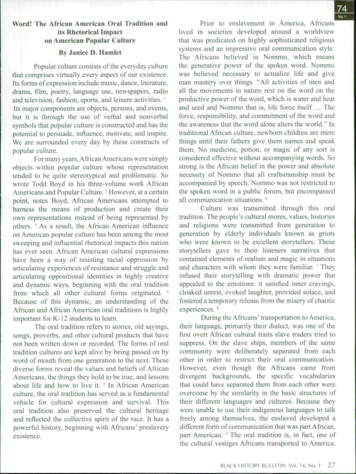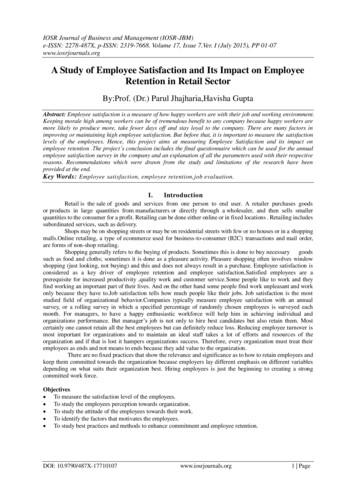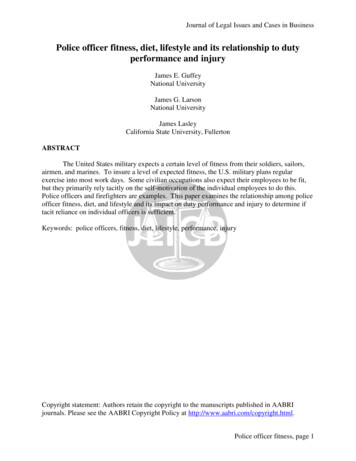
Transcription
Internal Communication - Its Role and Performance in Developingthe Strategy of an OrganizationFlorentina PÎRJOL1Lia Lucica RADOMIR 2ABSTRACTThe present paper, entitled "Internal Communication - Its Role and Performance inDeveloping the Strategy of an Organization", aims to identify the importance of internalcommunication in any organization and especially to identify the way in which the strategy ofan organization is influenced by an efficient internal communication. Moreover, with the helpof the case study we will be able to identify what are the most efficient means ofcommunication in an organization and also what the employees of a company think aboutevery means of communication used inside the organization in which they work. The finalpurpose of the questionnaire used for the case study is to identify the role of internalcommunication within SC PROFI ROM FOOD SRL Company. The questionnaire is alsotrying to see which are the most efficient means of communication both between theemployees of the same department and the means of communication between differentdepartments. To obtain results as relevant as possible for the case study, the questionnairewas applied in several departments inside the organization. Through this case study we aimedto provide a clearer image of the means of communication and of how information istransmitted within a department but also at the company level.KEYWORDS: internal communication, strategic communication, means of communication,company strategy.JEL CLASSIFICATION: D22, D83, J28.1. INTRODUCTIONIn general, people want to work in an organization, whether public or private and especiallythey want to feel appreciated and respected. An employee works more effectively in anorganization where his needs are understood, where he has a good working environment thatenhances performances and of course, if he feels that he plays an important part in takingdecisions. But these goals are not so easily achieved. However, the successful achievement ofthese goals requires a continuous effort from the management organization that has to assign aparticular importance to internal communication, a step that has to be done in a systematicand organized manner through organizational structures of public relations and humanresources management.Communication is the basic flow that enables the performances of an organization. The wayin which resources are used and the way that goals are achieved depend entirely of its qualityand functionality.12West University of Timisoara, Romania, fparjol@yahoo.frSC NOSICON SRL, Romania, lia.radomir@yahoo.com52
Management and Economics ReviewVolume 1, Issue 1, 2016The internal public should be shown the same interest like the external public because theorganization depends on this to a greater extent. The internal public, respectively theemployees of the organization represent the mechanism that moves the entire organization.The present paper aims to identify how important internal communication is within theorganization’s strategy and how can this communication affect long-term goals. With the helpof the case study we also want to identify which are the communication channels with thehighest efficiency in transmitting information.In the theoretical part of this paper we approached topics like types of communication suchas internal and external communication, focusing mostly on the importance of internalcommunication. Furthermore, we listed some of the most important means of communicationinside an organization, referring in particular to the main ways of information used in internalcommunication. Another topic that we talk about in the theoretical part refers toorganizational communication and to the impact that this type of communication has on thegeneral policy of the organization.The questionnaire for the case study analyses the situation of the internal communicationsystem within SC Profi Rom Food SRL Company, being implemented in several departments.The questionnaire contains 20 questions and through the received answers we can establishhow efficient internal communication is inside the company and also what means oftransmitting the information are the most used by the employees.The paper includes information regarding the role of internal communication in a Romaniancompany. The implemented questionnaires cannot capture entirely the way in which internalcommunication affects the proper performance of the company. Although the people thatcompleted the questionnaires work in different departments, the number of the implementedquestionnaires is relatively small. However, we consider that the received answers illustratehow information circulates between departments and in what means of communicationemployees trust mostly. We also believe that this paper represents an image of the importanceof internal communication within SC Profi Rom Food SRL Company.2. INTERNAL COMMUNICATION.THE ROLE OF INTERNAL COMMUNICATIONInformation and communication are two different concepts, but closely related to each other.When we talk about information, we talk about the process of informing people, of tellingthem about certain news and providing them guidance and directives. Communication is theprocess that puts people in relationship with other people. But, when it comes tocommunication in an organization, we must mention the fact that there are two types ofcommunication: internal and external communication. External communication includesorganization’s relations with the external environment, namely with suppliers, businesspartners. Internal communication is the type of communication that develops inside anorganization, within the relations between human resources and the organization itself. It mayinclude managerial communication and communication on personnel level that can bepossible between people on the same hierarchical level or between members of differentdepartments. Internal communication main purposes are to: Present results and balance sheets; Transmit information, knowledge; Explain a new direction, a new project or a new method;It may be considered that internal communication included managerial communication andcommunication for the personnel (Radu, Tigu, Brandusoiu, State & Tuclea, 2003).53
Florentina PÎRJOL, Lia Lucica RADOMIRInternal communication is a key component in the process of building the image of anorganization, together with the external communication. Organizations are well seen by otherswhen its members are motivated, when they can face any problems encountered as they areproperly informed, when they are credible and have a positive attitude. The main purposes ofinternal communication are: Ensuring a good circulation of internal information; Operating each of the managerial functions; As part of the motivation process, communication makes possible the identification, theknowledge and the proper use of different category of needs; In working groups, enhances the links between the members, developing an internalenvironment based on trust; Within the organization personnel policies, communication contributes with positiveresults to the development of the processes of recruitment, selection, evaluation,improvement and staff promotion; Communication contributes to the possibilities of improving performances through theexisting feed-back in the process of communication.After receiving the communication, employees should return to their jobs and performbetter than before (Larkin & Larkin, 1994).2.1. Means of communicationCommunication is usually described as a flow of messages from a sender to a receiver using achannel (O’Hair, 2001).We need to choose some adequate means of communication, so that the process ofcommunication can take place in good conditions. This choice will be made depending oncertain parameters such as the content of the message to be transmitted, the internal culture ofthe organization and the receiver characteristics. Each way has specific characteristics thatmake it more or less suitable. The internal culture represents an important point in choosingthe appropriate means of communication, because it is necessary in the use of certain media.Searching for a better correspondence between the used means of communication and thereceiver to whom the message is addressed puts information officers in the situation to dividethe employees according to their perceptiveness to the channels of written, oral andaudiovisual communication.The main means of information used in internal communication are:2.1.1. Written communicationWritten communication is the most important tool used in internal communication. Thewritten messages must be clear, readable and they must contain short words known by mostpeople. The sentences must also be short, with a simple structure, containing a single idea orinformation. The substance must be placed at the beginning of the sentence.The media of written communication are: the memorandum, the report, the writteninstructions, the manifest, the poster or the bill poster, the company newspaper, the pressmagazine, the survey, the box ideas and gestures information.2.1.2. Oral communicationOral communication presents a series of advantages that often makes it very important. Itgenerates interactions that can be both verbal and nonverbal. This way of communicationrepresents the main resort of information, negotiation and decision making processes withinthe company. Its double cognitive and affective dimension makes it a prime factor: Of knowledge and recognition; Of elaborating a common language; Of interaction; Of message distortion54
Management and Economics ReviewVolume 1, Issue 1, 2016Conveying information into oral communication requires a special training and organization;The media of oral communication are: the telephone or mobile phones, individual discussions,meetings, conference, the visit in the organization, the quality circles.2.1.3. Audio-visual communicationA presentation made with the help of an audiovisual media will bring more clarity on what itwas said, making it more interesting and easier to remember. In the audio-visualcommunication we meet the following media: overhead projector, slides, block notes, theinformation movie, e-mail, video transmission, cable television.2.1.4. Strategic communicationCismaru (2010) defines strategic internal communication as being a set of actions of plannedcommunication, with preset objectives, with the help of which information, performance andtrust in the organization are maintain between the employees.The employees are the key public for the organization, although most of the timesorganizations neglect the internal public. At first sight, the organization addresses to a widepublic, to whom it presents the organization’s services. The strategic communication has animpact on the general policy of the organization through two aspects, namely: apart from thecustomers, the other categories connected with the organization are also important inmaintaining a favourable environment. The second aspect is that, that these categories are nothomogeneous. Moreover, the messages sent as well as the plan and the means ofcommunication must be specific to each category. To these categories belong the mass-media,the suppliers, the distributors, the employees, the employees’ families, the partnerorganization and the competing organizations. The internal public of an organization ishomogeneous only in case of a small organization.The internal communication activity is conducted according to some well establish stages:research, planning and the implementation and evaluation of the plan. Planning is animportant stage for an efficient strategic communication process. If this stage is notaccomplished in the smallest details, it can amplify the negative aspects that already exist inthe organization. The lack of a good communication plan can lead to: Failure in achieving communication goals and image; A poor organization of the specialized department; A poorly organized internal information;Prutianu (2004) proposes the following guidelines for proper communication objectives: The objective should express a noticeable action at the level of behaviour, attitudes andopinion; The content of the action that will externalize the desirable behaviour should be specified; The conditions of achievement in relation with who the performances make sense mustalso be specified;Two types of strategies are most often used in internal communication, namely:a)Activities of disseminating the informationThis process is adopted in relation to the informational goals and has as a final purpose thedistribution of representative messages for the organization, products and services offered byit. The tactics that can be used in this strategy are information, internal advertising, the speechof some personalities within the organization, the exposure of informative media in internalpublic reunions.b)Organization of eventsThis strategy also aims at transmitting information. The tactics may be: the reaction to anunexpected event, ceremonies, and the events staged for the media, contests and competitions.From the internal communication perspective there are two types of events: events organizedfor the internal public and events organized for the external public.55
Florentina PÎRJOL, Lia Lucica RADOMIREvaluation is a stage of the communication plan that aims the systematic analysis of thedevelopment of the internal communication process and its results. Through this stage one canidentify the successes, but also the failures, the progresses registered in terms of informationand the image of the organization. It also allows the correction of errors, at minimal cost, forsimilar situations that may appear in the future. The evaluation shows not only if the proposedgoals were successfully fulfilled, but also if the communication plan was well designed andthe strategies and tactics appropriately used.3. METHODOLOGY AND DATA R
organization’s strategy and how can this communication affect long-term goals. With the help of the case study we also want to identify which are the communication channels with the highest efficiency in transmitting information. In the theoretical part of this paper we approached topics like types of communication such as internal and external communication, focusing mostly on the .



